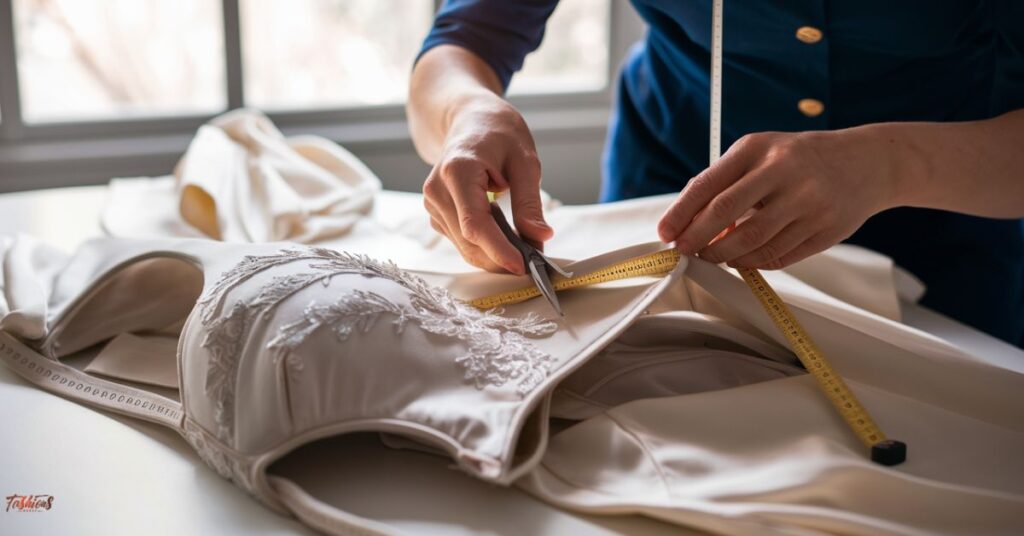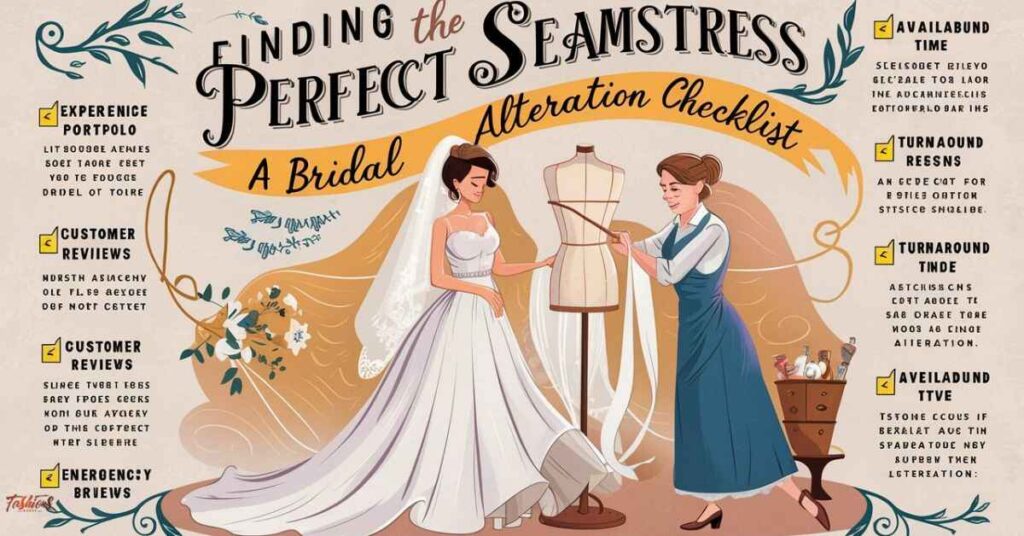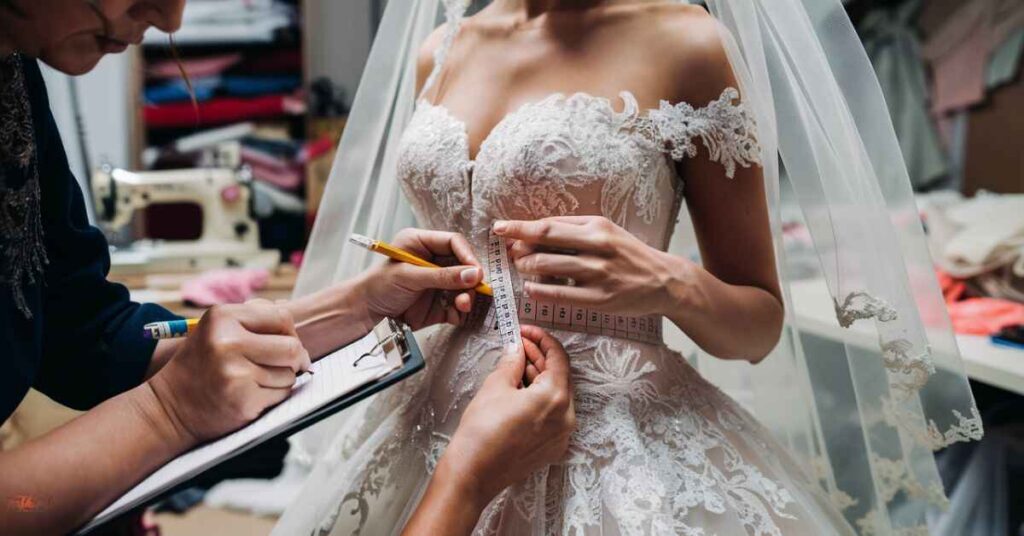As you stand before the mirror, adorned in your dream wedding dress, a wave of euphoria washes over you. However, the blissful moment is fleeting as you notice the gown doesn’t quite fit like a glove.
Fear not, for the art of dress alterations can transform your bridal vision into a stunning reality. Yet, amidst the excitement, a question looms.
In this comprehensive guide, we’ll unravel the intricate world of bridal gown tailoring, providing you with a detailed cost breakdown and expert insights to ensure you look and feel like a million dollars on your special day.
Types of Wedding Dress Alterations
Basic Modifications: These include adjustments to the gown’s length, taking in or letting out the seams, and minor tweaks to the bodice.
Advanced Tailoring: This involves more intricate changes such as reshaping the neckline, adding sleeves or straps, and customizing the gown with embellishments.
Structural Alterations: For brides who want significant changes, structural alterations like corset adjustments, adding bra cups, or altering the silhouette are options.
Embellishment Enhancements: Adding decorative elements like beading, lace embroidery, or appliques can elevate the gown’s overall look.
Understanding these alteration categories will help you communicate effectively with your dressmaker and make informed decisions about the modifications you want.
Decoding the Factors that Influence Alteration Costs
In the realm of wedding dress alterations, understanding the intricate factors that sway pricing is paramount. Let’s decode these factors to shed light on how they influence alteration costs:
Dress Fabric Complexity
The fabric of your wedding dress plays a pivotal role in alteration complexity and subsequent costs. Delicate fabrics like silk, satin and lace require meticulous handling and specialized techniques, which can escalate alteration expenses. The intricacies of working with these fabrics demand expertise and precision from the seamstress or tailor, contributing to higher rates for alterations.
Extent and Number of Alterations Needed
The scope and magnitude of alterations needed directly impact the total price of dress modifications. Simple adjustments such as hemming or taking in the sides generally incur lower costs compared to extensive changes like reshaping the neckline, altering the silhouette, or adding embellishments.
Multiple alterations compounded by their complexity contribute to higher alteration expenses, reflecting the time, effort, and skill required to achieve desired modifications.
Seamstress/Tailor’s Expertise and Location
The experience and proficiency of the seamstress or tailor significantly influence alteration rates. Seasoned professionals with a wealth of expertise and a track record of quality craftsmanship often command higher fees for their services.
Moreover, the geographical location of the tailor can also impact pricing, with tailors in major cities or upscale areas typically charging more than those in smaller towns or rural settings.
The combination of expertise and location plays a pivotal role in determining alteration rates, reflecting the value of skilled craftsmanship and local market dynamics.
Time Constraints and Rush Fees
Time constraints can introduce additional costs in the form of rush fees for short notice alterations. Brides requiring expedited services to meet tight deadlines may incur higher alteration expenses due to the accelerated timeline and prioritized scheduling.
Rush fees compensate for the seamstress or tailor’s expedited work and the logistical challenges of accommodating urgent alteration requests. Planning ahead and allowing ample time for alterations can mitigate rush fees and contribute to a more cost-effective alteration experience.
Understanding these factors empowers brides to navigate the intricacies of wedding dress alterations with clarity and informed decision-making, ensuring a seamless and rewarding alteration process tailored to their preferences and budget.
Unveiling the Average Costs: A Detailed Breakdown
Now that we’ve explored the factors influencing alteration costs, let’s dive into the nitty-gritty of pricing. Keep in mind that these figures are approximate and may vary based on your specific needs and location.
Bodice Alterations

The bodice, or torso area, is a common point of alteration for many brides. Here’s a breakdown of typical costs:
Reshaping the Neckline: $30 – $100
Adding Bra Cups: $20 – $50
Corset Adjustments: $100 – $150
Taking In or Letting Out the Seams: $50 – $250
Skirt Alterations
The skirt is often the canvas for various modifications, from hemming to bustle additions. Prepare for the following potential costs:
Hemming the Dress: $150 – $450
Adjusting Lace: $120 – $250
Beading Adjustments: $20 – $40
Removing the Train: $30 – $100
Lining: $30 – $50
Shortening & Reshaping: $150 – $400
Adding a Bustle: $30 – $400
The cost varies based on the number of bustle points (attachment points for the gathered skirt):
1-3 points: $10 – $30
3-5 points: $30 – $60
5-7 points: $60 – $100
7+ points: $100+
General Skirt Adjustments (taking in or letting out): $20 – $40
Waist Alterations
Ensuring the perfect fit around your waistline is crucial for a flattering silhouette. Expect to pay approximately $100 – $250 for waist alterations.
Embellishments & Additions
If you’re dreaming of adding a touch of glamour or personalization to your gown, be prepared for the following costs:
Embroidery or Beadwork: $30 per hour
Adding a Belt or Sash: $20 – $40
Strap & Sleeve Alterations
Don’t forget about those delicate details that complete your bridal look:
Altering Sleeve Length: $30 – $100
Adding or Adjusting Straps: $20 – $60
Case Study: A Bride’s Journey
To illustrate the potential costs, let’s follow the journey of Sarah, a bride-to-be who purchased a beautiful satin gown for her upcoming nuptials.
Sarah’s dress alterations included:
Reshaping the neckline: $75
Taking in the bodice seams: $150
Hemming the skirt (with lace adjustments): $300
Adding a 5-point bustle: $70
Adjusting the waistline: $175
Sarah’s total alteration cost: $770
While this may seem like a significant investment, Sarah’s seamstress ensured her dress fit like a dream, allowing her to radiate confidence and joy on her special day.
Navigating the Alteration Process: Tips from the Experts
While the cost breakdown provides a general guide, navigating the alteration process itself can be daunting. Fear not, for we’ve consulted industry experts to share their invaluable tips and insights.
Determining the Right Number of Fittings

Most brides require at least two to three fittings to ensure the perfect fit,” advises Jessica, a seasoned bridal consultant. The first fitting allows the seamstress to assess the necessary modifications, the second checks the progress, and the final fitting ensures everything is flawless before the big day.
Communicating Your Vision Effectively
Jenna, a renowned couturier, emphasizes the importance of clear communication:
During your initial consultation, don’t hold back! Share your vision, inspirations, and any specific requests you may have. Provide reference images and be open to your seamstress’s suggestions. This collaborative approach ensures your dream dress becomes a reality.”
Considering Customizations and Their Associated Costs
While alterations focus on achieving the perfect fit, customizations take it a step further by personalizing your gown. Sarah, a recent bride, shares her experience:
I wanted to incorporate my grandmother’s lace into my dress as a special tribute. My seamstress quoted an additional $500 for this intricate customization, but it was worth every penny to have that sentimental touch.
Read this blog:
How To Pick A Wedding Dress?
The Pros and Cons of Flat-Rate vs. A La Carte Alteration Pricing
When it comes to wedding dress alterations, understanding the differences between flat-rate and a la carte pricing models can significantly impact your overall experience and expenses. Let’s delve into the pros and cons of each approach, along with tips for negotiating the best deal:
Flat-Rate Pricing
Pros:
Simplicity and Predictability: Flat-rate pricing offers simplicity by providing a fixed cost for standard alterations. This predictability allows brides to budget more effectively without surprises.
Inclusive Services: Many flat-rate packages include a range of alterations, such as hemming, bodice adjustments, and sleeve modifications. This comprehensive approach can be convenient for brides seeking multiple alterations.
Potential Cost Savings: For brides requiring several alterations, a flat-rate package can result in cost savings compared to a la carte pricing for each individual adjustment.
Cons:
Limitations on Customizations: Flat-rate packages may have limitations on customizations or additional embellishments. Brides seeking unique alterations beyond the standard offerings may incur extra charges.
Overpayment for Minimal Adjustments: If your gown requires only minor alterations, such as hemming or simple bodice adjustments, a flat-rate package might lead to overpayment compared to a per-service pricing model.
A La Carte Pricing
Pros:
Customization Flexibility: A la carte pricing allows for tailored pricing based on specific alterations needed. Brides can choose only the services required, avoiding unnecessary charges for unneeded adjustments.
Transparent Cost Breakdown: With a la carte pricing, each alteration service is itemized, providing transparency in cost breakdown. Brides can see exactly what they are paying for each modification.
Ideal for Minimal Alterations: If your gown requires minimal adjustments or only one specific alteration, opting for a la carte pricing ensures you pay only for the services utilized.
Cons:
Potential Cost Variability: A la carte pricing can lead to variability in costs, especially if unexpected alterations arise during fittings. This variability may make budgeting more challenging.
Complexity in Cost Estimation: For brides unfamiliar with alteration terminology or the extent of modifications needed, estimating costs under an a la carte model may be more challenging.
Situational Suitability
Flat-Rate Pricing: Ideal for brides needing multiple standard alterations without extensive customizations. It offers convenience, predictability, and potential cost savings for comprehensive alterations.
A La Carte Pricing: Suited for brides with specific alteration needs or minimal adjustments. It provides flexibility, transparency, and cost-effectiveness for tailored services.
Tips for Negotiating the Best Deal
Clarify Included Services: Understand exactly what services are included in a flat-rate package to avoid unexpected charges for additional alterations.
Request Detailed Quotes: For a la carte pricing, request itemized quotes listing each alteration service and its associated cost. This transparency aids in cost estimation.
Discuss Customization Costs: If opting for a la carte pricing and considering customizations, inquire about pricing for these additional services upfront to avoid surprises.
Consider Bundle Discounts: Some providers may offer bundle discounts for combining multiple alterations under a flat-rate package. Inquire about potential savings for bundling services.
Review Terms and Policies: Before finalizing any pricing agreement, review the provider’s terms, cancellation policies, and warranty/guarantee offerings for added peace of mind.
By weighing the pros and cons of flat-rate versus a la carte pricing models and leveraging negotiation tips, brides can navigate the wedding dress alteration process effectively.
Finding the Perfect Seamstress: A Bridal Alteration Checklist
Your wedding dress alterations are crucial to achieving that perfect fit and style on your big day. Here’s a comprehensive checklist to help you find the ideal seamstress for your bridal alterations:

Seek Recommendations
Friends and Family: Ask recently married friends or family members for recommendations. Personal referrals often lead to trustworthy and skilled seamstresses.
Bridal Shops: Inquire at bridal boutiques where you purchased your gown. They often have experienced seamstresses or can recommend reliable professionals.
Online Communities: Join online wedding forums or groups where brides share their alteration experiences and recommend seamstresses in your area.
Evaluate Experience and Reputation
Years of Experience: Look for seamstresses with extensive experience in bridal alterations. Experienced professionals are adept at handling delicate fabrics and intricate designs.
Customer Reviews: Check online platforms like Yelp, Google Reviews, or social media for customer feedback and ratings. Positive reviews indicate quality service and customer satisfaction.
Portfolio Inspection: Request to see a seamstress’s portfolio showcasing their previous bridal alteration work. This allows you to assess their skill level and attention to detail.
Communication and Attention to Detail
Initial Consultation: Schedule an initial consultation with potential seamstresses. Evaluate their communication style, responsiveness, and ability to understand your alteration needs.
Attention to Detail: During the consultation, observe how the seamstress examines your dress and discusses alteration options. A keen eye for detail is crucial for achieving a flawless fit.
Clear Communication: Ensure the seamstress clearly explains the alteration process, timeline, and any associated costs. Transparent communication prevents misunderstandings later on.
Customization Capabilities and Pricing Transparency
Customization Discussion: If you desire customizations beyond standard alterations, discuss these ideas with the seamstress. Inquire about their expertise in embellishments, beadwork, or structural changes.
Pricing Breakdown: Ask for a detailed breakdown of alteration costs. A reputable seamstress provides transparent pricing, including fees for different alteration types and any additional charges.
Negotiation and Contracts: If necessary, negotiate pricing based on your alteration needs. Ensure all agreements, including timelines and costs, are documented in a written contract for clarity and accountability.
By following this checklist and conducting thorough research, you’ll be well-equipped to find a skilled and reliable seamstress who can bring your dream wedding dress to life through expert alterations.
Also Read:
What Color Tux With Navy Prom Dress?
Bridal Veil Alterations: An Additional Consideration
Your bridal ensemble is incomplete without the perfect veil. Here’s a closer look at bridal veil alterations and essential tips for coordinating them seamlessly with your dress alterations:
Fabric Types:
Tulle Veils: Average alteration costs range from $50 to $200, depending on the length and complexity of alterations.
Lace Veils: Expect alterations to cost between $100 and $300, considering the intricacy of lacework and design modifications.
Silk Veils: Alteration prices vary widely, starting from $150 for simple adjustments and reaching up to $500 for detailed silk veils.
Veil Length:
Shoulder-Length Veils: Alterations typically range from $50 to $150, focusing on hemming and fitting adjustments.
Chapel-Length Veils: Plan for alterations costing $100 to $250, considering hemming, layering, and embellishment additions.
Cathedral-Length Veils: Expect higher alteration expenses ranging from $200 to $500, especially for intricate designs and extensive modifications.
Embellishments:
Beading or Sequins: Additional embellishments may incur costs of $50 to $200, depending on the complexity and materials used.
Lace Appliques: Incorporating lace appliques into the veil can add $100 to $300 to the alteration expenses, considering the intricacy of placement and sewing.
Tips for Coordinating Veil and Dress Alterations Seamlessly

Consultation Coordination: Schedule both your dress and veil alteration consultations with the same seamstress or at the same boutique. This ensures a cohesive vision and consistent alterations across both pieces.
Matching Fabric and Details: Provide your seamstress with fabric swatches or photos of your dress’s fabric and embellishments. This helps in matching the veil’s material and details for a harmonious look.
Timeline Alignment: Coordinate the alteration timelines for your dress and veil to ensure they are ready for final fittings together. Factor in any additional time needed for customizations or intricate work.
Trial Run: Schedule a joint fitting session where you try on both the dress and veil together. This allows for adjustments to be made if any discrepancies arise in the overall look or fit.
Communication Is Key: Clearly communicate your preferences for veil alterations, such as adding or removing layers, adjusting the blusher length, or incorporating specific embellishments. Be open to suggestions from the seamstress for optimal coordination.
By considering these average costs and following the tips for seamless coordination, you can ensure that your bridal veil complements your dress flawlessly, enhancing your overall bridal look with elegance and style.
Frequently asked questions
How much does it cost to get your wedding dress adjustments?
The cost of wedding dress adjustments can range from $100 to $1000, depending on the complexity and type of alterations needed.
Why are wedding dress alterations so expensive?
Wedding dress alterations are often expensive due to factors like the intricacy of the design, fabric type and the expertise required to tailor the dress perfectly.
How big is too big to alter a wedding dress?
Alterations that require significant resizing, especially more than two sizes, may pose challenges and may not always yield optimal results.
How many sizes can you adjust a wedding dress?
Typically, wedding dresses can be adjusted by about one to two sizes without compromising the overall look and structure.
How long before your wedding should you get your dress altered?
It’s recommended to start dress alterations about 4-6 months before the wedding to allow sufficient time for fittings and adjustments.
Do wedding dresses always need alterations?
While not all wedding dresses need alterations, most brides opt for adjustments to ensure a perfect fit and enhance the overall look of the gown.
Conclusion
Understanding the costs and intricacies of wedding dress and veil alterations is crucial for brides seeking a perfect fit and look on their special day. From decoding the factors influencing alteration costs to navigating the alteration process effectively, this comprehensive guide provides valuable insights and tips.
Whether opting for flat-rate or a la carte pricing models, knowing what to expect and how to negotiate ensures a smooth experience. Additionally, finding the right seamstress through recommendations and thorough evaluations is key to achieving desired results. By considering these factors and following expert advice, brides can confidently navigate the world of bridal alterations, ensuring a stunning and tailored ensemble that reflects their unique style and personality.







